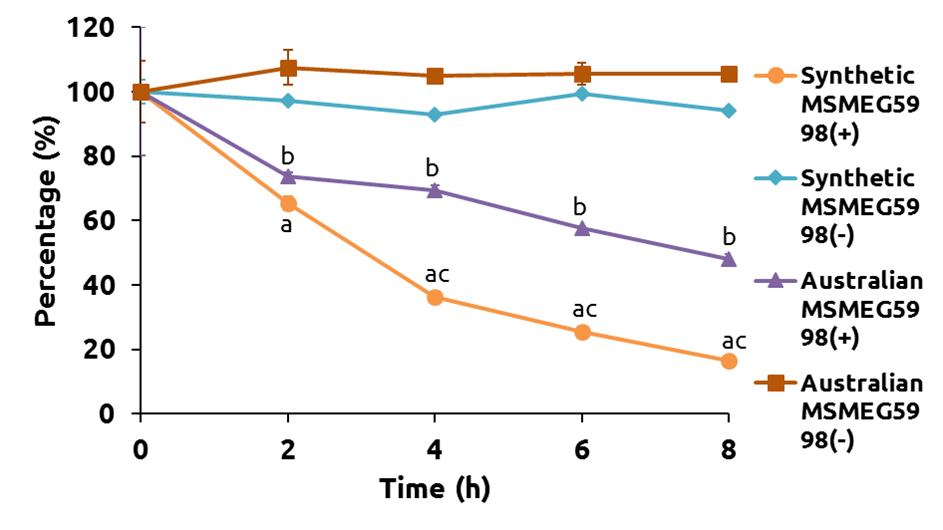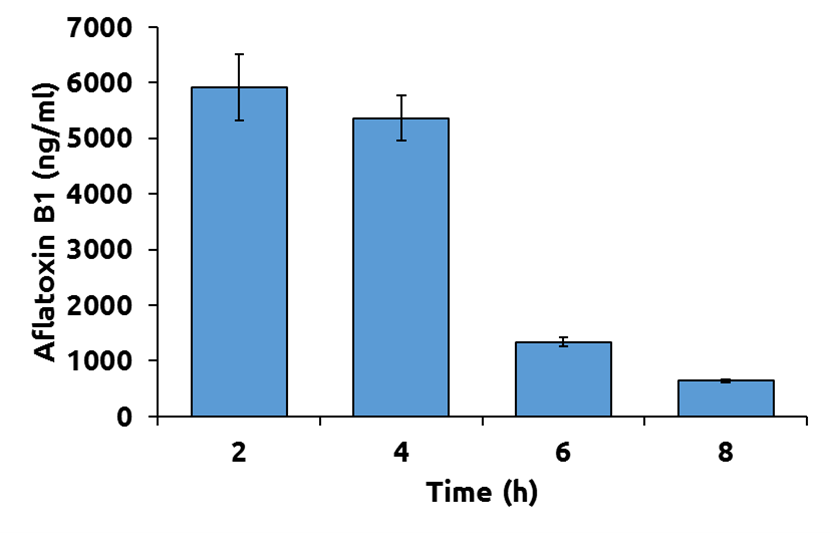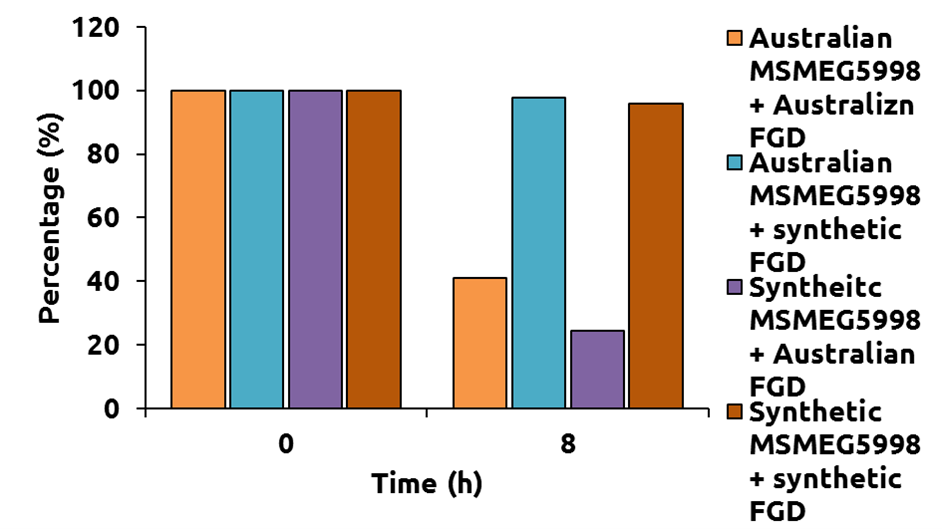Part:BBa_K2382001
MSMEG_5998
Sequence and Features
- 10COMPATIBLE WITH RFC[10]
- 12COMPATIBLE WITH RFC[12]
- 21COMPATIBLE WITH RFC[21]
- 23COMPATIBLE WITH RFC[23]
- 25INCOMPATIBLE WITH RFC[25]Illegal AgeI site found at 428
- 1000COMPATIBLE WITH RFC[1000]
Usage and Biology
This is an enzyme that could degrade aflatoxin with the aid of coenzyme F420. It belongs to the F420H2-dependent reductases family from Mycobacterium Smegmatis.
Contents
Characterization of the MSMEG_5998
Expression results
IPTG induction
First, we transformed plasmid (encodes MSMEG_5998) from Australia into E. coli BL21 (DE3) strain to express protein. Then IPTG was used to induce the expression system since all plasmids in our project had T7 promoter. We sonicated E. coli and did 9500 rpm and 13000 rpm centrifugation to remove the cell pellet and obtain the supernatant. To confirm the suitable concentration of cell supernatant, we did SDS-PAGE electrophoresis and coomassie brilliant blue staining. The result is demonstrated in the Fig. 1A. After centrifuging two times, we could find a high percentage of proteins in the cell supernatant (the 13000 Su group).

Protein purification, and dialysis
After extracting the cell lysates, we used nickel-resin column to purify our target proteins from the cell lysates because all of our proteins were tagged with 6 histidines at their C-terminal ends. After protein purification, protein dialysis with diaysis buffer containing 150 mM NaCl, 20 mM Tris-HCl (pH=7.5), and 20% glycerol to remove imidazole in our purified proteins, we did SDS-PAGE gel electrophoresis to ensure our target proteins were successfully purified (Fig. 2A ). The molecular weights of these proteins are listed in the Table 1. The standard BSA proteins were used to quantify the concentration of target proteins.
| Proteins | Molecular weight |
| Australian MSMEG5998 | 18.9 kDa |
| Australian FGD | 37.7 kDa |
Protein solubility analysis
To know whether the solubility of our two enzymes (MSMEG_5998 and FGD BBa_K2382002) increased after fusing enzymes with thioredoxin, we dissolved all cell lysates which containing pellet and supernatant and did western blot to detect the content of our target proteins. All proteins were detected by anti-6x His Tag antibody because all of them contained a 6-histidines tail when bacteria expressed them. In Fig. 3, we could find there was good expression of both Australian and synthetic MSMEG5998 in the “13000 Su” group when compared with the “13000 P” group. This result meant that most proteins were dissolved in the supernatant while few proteins deposited in the cell pellet after 13000-rpm centrifugation. However, we could not observe good solubility in both Australian and synthetic FGD because there were little or no difference between the “13000 Su” group and the “13000 P” group.
Protein Expression Over Time
We transformed the plasmids that contained MSMEG_5998(BBa_K2382001) and Thioredoxin-MSMEG_5998 fusion protein(BBa_K2382009) respectively into competent cell E.coli BL21. After cultured overnight, measure the ABS600 and diluting the LB medium to O.D.=0.1. Then incubate at 37℃, 150 rpm until the O.D. of the samples reach 0.4 to 0.6 . Add 80ul 100mM IPTG( final concentration : 0.4mM ) to 125 ml flask and return to 37°C. From then on, after measure the O.D. values, transfer 1 ml from the induced sample and centrifuge at maximum speed for 60 seconds at RT and remove supernatant at 0, 1, 2, 3, 4, 5, 6, 7, 8 hours and 0, 0.5, 1.0, 1.5, 2.0 ,2.5 , 3.0, 3.5, 4 hours. Then we use Western Blot mehtod to amalyze the quantaty of MSMEG_5998 at each time spot. </p>
Discussion
According to the data shown above, the growth curve of E.coli BL21 with Synthetic MSMEG_5998 reached the ceiling when the O.D. value was approximately at 2 while the amount of Synthetic MSMEG_5998 were still increasing.
Though the amount of Synthetic MSMEG_5998 increased consistently with time, we could not jump to conclusions that it was proper to incubate E.coli as long as possible. Another consideration was the time it would take. Just as our expected, it growed fast at the first 2.5 hours. That’s why we also chose 2.5hr after induced by IPTG when we extracted Synthetic MSMEG_5998 from total cell lysate in other experiments.
Based on previous experience, if the E.coli was incubated over 4 hours, the protein that it expressed may be degraded or mis-folded, leading to malfunction. As a result, it was also an important issue for this modeling. However, because of the lack of F420, we did not have the chance to check the enzyme activity of each time spot. It was still unknown whether the titer of the Synthetic MSMEG_5998 would change or not and awaited further research.
Enzyme Function Results
Enzyme Activity Assay
The conditions of reaction to degrade aflatoxin by MSMEG5998 were modified from Taylor’s study[6]. All concentrations of reactants are listed in Table 2 and 32 μM aflatoxin was used. We first mixed all reactants in eppendorfs and then put them at 22°C.
In Fig. 7A, we compared two proteins, MSMEG5998 and F420-dependent glucose-6-phosphate dehydrogenase (FGD) expressed from Taylor’s vectors (from Australia) and from our synthetic vectors. We found that both the Australian and synthetic MSMEG5998 have great activity and degraded aflatoxin B1 by more than 60%. The effect of the synthetic one may be better than the Australian one but there were no statistic significance.
| Name | Concentration |
| Aflatoxin B1 | 32 or 10 μM |
| MSMEG5998 | 0.1 μM |
| Reactants |
| Glucose-6-phosphate (G6P) | 2.5 mM |
| F420 | 5 μM |
| F420-dependent glucose-6-phosphate dehydrogenase (FGD) | 0.225 μM |
| Tris-HCl (pH=7.5) | 25 mM |
However, only Australian FGD has activity to reduce F420 into F420H2 and help the reaction. This finding corresponds with our dry lab results. Therefore, we used Australian and synthetic MSMEG5998 and Australian FGD to do the same experiment again to figure out whether the degradation percentage was dependent of time and whether the main reason of degradation was MSMEG5998.
</p>


The results were detected by direct 365 nm absorbance (Fig. 7B) and by ELISA (Fig. 7C). We found out that the degradation percentage was time-dependent. The synthetic MSMEG5998 had better activity than Australian MSMEG5998. The former was able to degrade 83% aflatoxin after 8 h while the latter could only degrade 52% aflatoxin.
MSMEG5998 alleviated aflatoxin-induced p53 pathway activation in HepG2
Cells (5×105/ 3.5 cm dish) were divided into 5 groups: control group, aflatoxin group (treated with 10 μM), aflatoxin + reactants group (treated with aflatoxin 10 μM and reactants as Table 2), aflatoxin + reactants + MSMEG5998 group (treated with aflatoxin 10 μM, reactants in Table 2 and synthetic MSMEG5998 0.1 μM), and MSMEG5998 group (treated with synthetic MSMEG5998 0.1 μM).

After 24 h treatment, cells were lysed and their protein expression was analyzed by western blot. In Fig. 8, we found that the expression of p-Chk1 (Ser345), p-Chk2 (Thr68), p-p53 (Ser20), p53, and p21 were all decreased by MSMEG5998 and other reactants when compared to the aflatoxin alone group. This result may attribute to the highly desirable activity of MSMEG5998 of degrading aflatoxin and preventing the toxin from entering cells.
Unexpectedly, we also observed a lower expression of these proteins in the aflatoxin + reactants group, which meant that MSMEG5998 may not be the only factor that inhibit the activation of p53 pathway in HepG2 cells. Besides, to ensure that our enzyme MSMEG5998 would not be toxic to cells, we designed a group of MSMEG5998 alone and found that it resembles expression of these proteins as the control group. The results showed that this enzyme was safe.
Cloning Results
To insert MSMEG5998 gene into our shuttle vector for E. coli and yeast, pG1-EX1, we first designed two specific primers which contain BamHⅠ (the 5’ end one) and XhoⅠ (the 3’ end one) independently. Second, we did PCR to amplify our gene (the insert) and digested this gene with BamHⅠ and XhoⅠ. At the same time, we digested our plasmid with the same two restriction enzymes to prepare the vector. All results were checked by DNA electrophoresis before ligation. Then we used DNA ligase to ligate the insert and the vector and transformed this recombinant plasmid into E. coli (DH5α). The transformation result was shown in Fig. 9A. To check whether the construction was successful, we picked twenty colonies (cultured in another dish and showed in Fig. 9B) and extracted their plasmids. Then we did colony PCR to see whether the plasmids in these twenty colonies contained the MSMEG5998 gene. If the E. coli carried the recombinant plasmid, we could observe a clear band in about 700 bp. The DNA electrophoresis results were demonstrated in Fig. 9C. We found that most of the colonies carried the recombinant plasmid. Finally, after amplifying our recombinant plasmids in E. coli, we extracted the plasmids and transformed into yeasts to make them express the recombinant protein. There is one gene related to synthesize tryptophan in pG1-EX1, if our recombinant plasmid was successfully transformed into yeast and it could enable yeast to grow on the medium lacking tryptophan. The transform results were demonstrated in Fig. 9D.
References
(1)Taylor, M.C., et al., Identification and characterization of two families of F420H2‐dependent reductases from Mycobacteria that catalyse aflatoxin degradation. Molecular microbiology, 2010. 78(3): p. 561-575.
(2)Lapalikar, G.V., et al., F420H2-dependent degradation of aflatoxin and other furanocoumarins is widespread throughout the Actinomycetales. PLoS One, 2012. 7(2): p. e30114.
(3)Mersch-Sundermann, V., et al., Use of a human-derived liver cell line for the detection of cytoprotective, antigenotoxic and cogenotoxic agents. Toxicology, 2004. 198(1): p. 329-340.
(4)Mah, L., A. El-Osta, and T. Karagiannis, γH2AX: a sensitive molecular marker of DNA damage and repair. Leukemia, 2010. 24(4): p. 679-686.
(5)Hirao, A., et al., DNA Damage-Induced Activation of p53 by the Checkpoint Kinase Chk2. Science, 2000. 287(5459): p. 1824.
(6)Shieh, S.-Y., et al., The human homologs of checkpoint kinases Chk1 and Cds1 (Chk2) phosphorylate p53 at multiple DNA damage-inducible sites. Genes & development, 2000. 14(3): p. 289-300.
(7)ohn, K.W., Molecular interaction map of the mammalian cell cycle control and DNA repair systems. Mol Biol Cell, 1999. 10(8): p. 2703-34.
(8)Taylor, M.C., et al., Identification and characterization of two families of F420H2‐dependent reductases from Mycobacteria that catalyse aflatoxin degradation. Molecular microbiology, 2010. 78(3): p. 561-575.
Contribution: Hong Kong JSS 2021
Usage and Biology
FDR is a family of enzymes produced by bacterial species that catalyze the reduction of aflatoxin and lead to their spontaneous degradation and produce a non-toxic product. [1]
This enzyme can be found in bacterial strains such as Mycobacterium sp., Arthrobacter sp., and Pseudomonas sp.. The native function of the enzymes in these organisms is for methanogenesis [2], antibiotic resistance [3], and other redox-related metabolic activities. Nevertheless, it was believed that FDR’s native functions do not involve aflatoxin degradation since the above bacterial species seldom exist near any source of aflatoxin. Thus, it was a novel finding that FDRs are involved in the degradation of aflatoxin and there was considerable interest in the study of FDRs properties recently. [1]
In iGEM competition, 2012 Team UCL London, 2012 Team Bielefeld-Germany, 2018 Team HKUST, and 2019 Team MITADTBIO have explored the use of laccase to degrade Polyethylene plastic (BBa_K729002) and showing the enzymatic property of laccase (BBa_K863005). The teams have demonstrated that the laccase protein can be heterogeneously expressed in E. coli and being secreted to the extracellular spaces.
In our project, we also aim to investigate the AFB-1 degrading activity of FDR-A.
Aflatoxin (AF) is a family of carcinogenic toxins produced by Aspergillus sp.. According to the World Health Organization (WHO), 25% of food crops are destroyed due to aflatoxin contamination each year. About 5 billion people are at risk of chronic AF exposure and more than 80% of them will develop AF-related diseases such as hepatocellular carcinoma and liver failure. [4] Among all AF, aflatoxin B1 (AFB1) is considered the most potent and chronic. [5]
Among all species reviewed, Mycobacterium smegmatis was found to have the FDRs with the highest activity in AFB-1 degradation [6].
And from all the loci of the two FDR families (FDR-A and FDR-B) in M. smegmatis, FDR-A at locus MSMEG_5998 was found to have the highest enzymatic activity in degrading AFB1, AFB2, and AFG1. [1]
Che-Hsing Li, et al. (2019) had demonstrated that purified FDR-A from E. coli is able to retain its enzymatic activity in degrading AFB1 and iGEM 2017 Team CSMU_NCHU_Taiwan had demonstrated that FDR-A secreted by yeast is able to degrade AFB1 (This part). Therefore, we hypothesize that FDR-A would also show the high efficiency of AFB1 degradation in our project setting.
Moreover, literature showed that adding co-factors F420H2 can enhance the enzymatic activity of the FDR-A, so in our detoxifying spray, we planned to add the F420H2 cofactor with anti-oxidants into the buffer and thus increasing the efficiency of AFB1 degradation in our product.
We have decided a basic part coding for FDR-A for our 2021 phase 1 iGEM project (BBa_K3746002) and expression composite parts of FDR-A (BBa_K3746010), (BBa_K3746011), and (BBa_K3746012).
Reference
[1] Taylor, M. C., Jackson, C. J., Tattersall, D. B., French, N., Peat, T. S., Newman, J., Briggs, L. J., Lapalikar, G. V., Campbell, P. M., Scott, C., Russell, R. J., & Oakeshott, J. G. (2010). Identification and characterization of two families of F420H2-dependent reductases from mycobacteria that catalyse aflatoxin degradation. Molecular Microbiology, 78(3), 561–575. https://doi.org/10.1111/j.1365-2958.2010.07356.x
[2] Graham, D.E., and White, R.H. (2002) Elucidation of methanogenic coenzyme biosyntheses: from spectroscopy to genomics. Nat Prod Rep 19: 133–147.
[3] Hasan, M.R., Rahman, M., Jaques, S., Purwantini, E., and Daniels, L. (2010) Glucose-6-phosphate accumulation in mycobacteria: implications for a novel F420-dependent anti-oxidant defense system. J Biol Chem 285: 19135– 19144.
[4] Organization WH. aflatoxin. Manuf Comput Solut. 2000;6(8):20-3
[5] Okwara, P. C., Afolabi, I. S., & Ahuekwe, E. F. (2021). Application of laccase in aflatoxin B1 degradation: A Review. IOP Conference Series: Materials Science and Engineering, 1107(1), 012178. https://doi.org/10.1088/1757-899x/1107/1/012178
[6] Verheecke, C., Liboz, T., & Mathieu, F. (2016). Microbial degradation of aflatoxin B1: Current status and future advances. International Journal of Food Microbiology, 237, 1–9. https://doi.org/10.1016/j.ijfoodmicro.2016.07.028
//function/degradation
//proteindomain/degradation
| biology | Mycobacterium smegmatis |
| protein | MSMEG_5998 |











